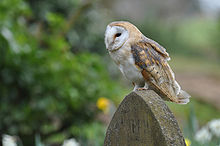Barn Owl
Facts
Also known as: White Owl, Silver Owl, Demon Owl, Ghost Owl, Death Owl, Night Owl, Rat Owl, Church Owl, Cave Owl, Stone Owl, Monkey-faced Owl, Hissing Owl, Hobgoblin or Hobby Owl, Dobby Owl,White Breasted Owl, Golden Owl, Scritch Owl, Screech Owl, Straw Owl, Barnyard Owl and Delicate Owl.
Conservation Status: Least Concern
Location: Worldwide (America, Africa, Europe, Asia, Australia)
Lifespan: Wild - About 2 years. Captive - Up to 25 years.
Also known as: White Owl, Silver Owl, Demon Owl, Ghost Owl, Death Owl, Night Owl, Rat Owl, Church Owl, Cave Owl, Stone Owl, Monkey-faced Owl, Hissing Owl, Hobgoblin or Hobby Owl, Dobby Owl,White Breasted Owl, Golden Owl, Scritch Owl, Screech Owl, Straw Owl, Barnyard Owl and Delicate Owl.
Conservation Status: Least Concern
Location: Worldwide (America, Africa, Europe, Asia, Australia)
Lifespan: Wild - About 2 years. Captive - Up to 25 years.
Scientific Classification
Kingdom: Animalia
Phylum: Chordata
Class: Aves
Subclass: Neornithes
Infraclass: Neognathae
Superorder: Neoaves
Order: Strigiformes
Family: Tytonidae
Subfamily: Tytoninae
Genus: Tyto
Species: T. alba
Binomial name: Tyto Alba
Kingdom: Animalia
Phylum: Chordata
Class: Aves
Subclass: Neornithes
Infraclass: Neognathae
Superorder: Neoaves
Order: Strigiformes
Family: Tytonidae
Subfamily: Tytoninae
Genus: Tyto
Species: T. alba
Binomial name: Tyto Alba
Description
Length: 25 to 45 cm (9.8 to 18 in)
Wingspan: 75 to 110 cm (30 to 43 in)
Other: The Barn Owl is a pale, long-winged, long-legged owl with a short squarish tail. Tail shape is a way of distinguishing the Barn Owl from true owls when seen in flight, as are the wavering motions and the open dangling feathered legs. The light face with its heart shape and the black eyes give the flying bird an odd and startling appearance, like a flat mask with oversized oblique black eyeslits, the ridge of feathers above the bill somewhat resembling a nose. The Barn Owl has acute hearing, with ears placed asymmetrically for improved detection of sound position and distance, and it does not require sight to hunt. Hunting nocturnally or crepuscularly, it can target and dive down, penetrating its talons through snow, grass or brush to seize rodents with deadly accuracy. Compared to other owls of similar size, the Barn Owl has a much higher metabolic rate, requiring relatively more food. Pound for pound, Barn Owls consume more rodents – often regarded as pests by humans – than possibly any other creature.
Length: 25 to 45 cm (9.8 to 18 in)
Wingspan: 75 to 110 cm (30 to 43 in)
Other: The Barn Owl is a pale, long-winged, long-legged owl with a short squarish tail. Tail shape is a way of distinguishing the Barn Owl from true owls when seen in flight, as are the wavering motions and the open dangling feathered legs. The light face with its heart shape and the black eyes give the flying bird an odd and startling appearance, like a flat mask with oversized oblique black eyeslits, the ridge of feathers above the bill somewhat resembling a nose. The Barn Owl has acute hearing, with ears placed asymmetrically for improved detection of sound position and distance, and it does not require sight to hunt. Hunting nocturnally or crepuscularly, it can target and dive down, penetrating its talons through snow, grass or brush to seize rodents with deadly accuracy. Compared to other owls of similar size, the Barn Owl has a much higher metabolic rate, requiring relatively more food. Pound for pound, Barn Owls consume more rodents – often regarded as pests by humans – than possibly any other creature.
Subspecies
Across its vast range, the Barn Owl has formed many subspecies, but several are considered to be intergrades between more distinct populations today. Still, some 20–30 seem to be worthy of recognition as long as the species is not split up. They vary mainly in size and color, sometimes according to Bergmann's and Gloger's Rules, sometimes more unpredictably. This species ranges in colour from the almost beige-and-white nominate subspecies, erlangeri and niveicauda to the nearly black-and-brown contempta:
Across its vast range, the Barn Owl has formed many subspecies, but several are considered to be intergrades between more distinct populations today. Still, some 20–30 seem to be worthy of recognition as long as the species is not split up. They vary mainly in size and color, sometimes according to Bergmann's and Gloger's Rules, sometimes more unpredictably. This species ranges in colour from the almost beige-and-white nominate subspecies, erlangeri and niveicauda to the nearly black-and-brown contempta:
- T.a alba
- T.a javanica
- T.a furcata
- T.a tuidara
- T.a guttata
- T.a delicatula
- T.a pratincola
- T.a punctatissima
- T.a poensis
- T.a thomensis
- T.a affinsis
- T.a guatemalae
- T.a deroepstorffi
- T.a bargei
- T.a sumbaensis
- T.a contempta
- T.a schmitzi
- T.a emesti
- T.a gracilirostris
- T.a meeki
- T.a detorta
- T.a erlangeri
- T.a stertens
- T.a crassirostris
- T.a interposita
- T.a hellmayri
- T.a bondi
- T.a niveicauda
Behaviour
The Barn Owl is nocturnal as usual for owls, but it often becomes active shortly before dusk already and can sometimes be seen during the day, when it relocates from a sleeping place it does not like.
The Barn Owl is nocturnal as usual for owls, but it often becomes active shortly before dusk already and can sometimes be seen during the day, when it relocates from a sleeping place it does not like.
Predators or Prey?
Most individuals manage to breed only once in their life, falling victim to predators or accidents before being 2 years of age. While wild Barn Owls are thus decidedly short-lived, the actual longevity of the species is much higher – captive individuals may reach 20 years or more. Predators of the Barn Owl include large American opossums, the Common Raccoon, and similar carnivorous mammals, as well as large raptors such as hawks, eagles, and other owls. Among the latter, the Great Horned Owl and the Eurasian Eagle-owl are noted predators of Barn Owls (though there is little evidence for predation on wild birds by Great Horned Owls). Some fall also victim to large snakes, but the biggest threat are humans and their pets, in particular house or feral cats. The Barn Owl's prey consist of rodents. These include mice, field mice, rats, field voles, and shrews.
Most individuals manage to breed only once in their life, falling victim to predators or accidents before being 2 years of age. While wild Barn Owls are thus decidedly short-lived, the actual longevity of the species is much higher – captive individuals may reach 20 years or more. Predators of the Barn Owl include large American opossums, the Common Raccoon, and similar carnivorous mammals, as well as large raptors such as hawks, eagles, and other owls. Among the latter, the Great Horned Owl and the Eurasian Eagle-owl are noted predators of Barn Owls (though there is little evidence for predation on wild birds by Great Horned Owls). Some fall also victim to large snakes, but the biggest threat are humans and their pets, in particular house or feral cats. The Barn Owl's prey consist of rodents. These include mice, field mice, rats, field voles, and shrews.
Diet
It hunts by flying low and slowly over an area of open ground, hovering over spots that conceal potential prey. They may also use fence posts or other lookouts to ambush prey. The Barn Owl feeds primarily on small vertebrates, particularly rodents. Studies have shown that an individual Barn Owl may eat one or more rodents per night; a nesting pair and their young can eat more than 1,000 rodents per year.
It hunts by flying low and slowly over an area of open ground, hovering over spots that conceal potential prey. They may also use fence posts or other lookouts to ambush prey. The Barn Owl feeds primarily on small vertebrates, particularly rodents. Studies have shown that an individual Barn Owl may eat one or more rodents per night; a nesting pair and their young can eat more than 1,000 rodents per year.
Habitat
This is a bird of open country such as farmland or grassland with some interspersed woodland, usually below 2,000 m ASL but occasionally as high as 3,000 m ASL in the tropics. This owl prefers to hunt along the edges of woods.
This is a bird of open country such as farmland or grassland with some interspersed woodland, usually below 2,000 m ASL but occasionally as high as 3,000 m ASL in the tropics. This owl prefers to hunt along the edges of woods.
Conservation
Barn Owls are relatively common throughout most of their range and not considered globally threatened. However, locally severe declines from Organochlorine (e.g. DDT) poisoning in the mid-20th century and rodenticides in the late 20th century have affected some populations. While the Barn Owl is prolific and able to recover from short-term population decreases, they are not as common in some places as they used to be. The most 1995-1997 survey put their British population at between 3,000 to 5,000 breeding pairs, out of an average of about 150,000 pairs (varying with rodent stocks) in the whole of Europe, for example. In the USA, Barn Owls are listed as endangered species in seven Midwestern states, and in the European Community they are considered a Species of European Concern.
Barn Owls are relatively common throughout most of their range and not considered globally threatened. However, locally severe declines from Organochlorine (e.g. DDT) poisoning in the mid-20th century and rodenticides in the late 20th century have affected some populations. While the Barn Owl is prolific and able to recover from short-term population decreases, they are not as common in some places as they used to be. The most 1995-1997 survey put their British population at between 3,000 to 5,000 breeding pairs, out of an average of about 150,000 pairs (varying with rodent stocks) in the whole of Europe, for example. In the USA, Barn Owls are listed as endangered species in seven Midwestern states, and in the European Community they are considered a Species of European Concern.
Reproduction
The breeding season usually starts in late March to early April. Breeding can take place at any time prey is abundant, and in the warm parts of its range may occur at any time of the year. An increase in rodent populations will usually soon cause the local Barn Owls to begin nesting; thus, even in the cooler parts of its range two broods are often raised each year. The male entices as are often used. Occasionally, nesting takes place in mine shafts and caves.
The breeding season usually starts in late March to early April. Breeding can take place at any time prey is abundant, and in the warm parts of its range may occur at any time of the year. An increase in rodent populations will usually soon cause the local Barn Owls to begin nesting; thus, even in the cooler parts of its range two broods are often raised each year. The male entices as are often used. Occasionally, nesting takes place in mine shafts and caves.



